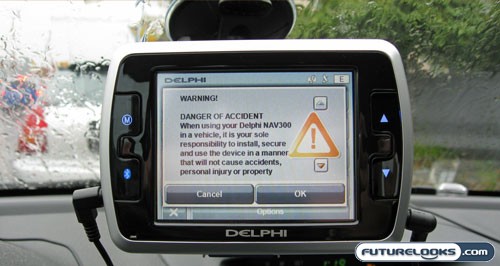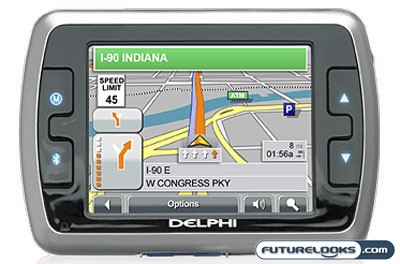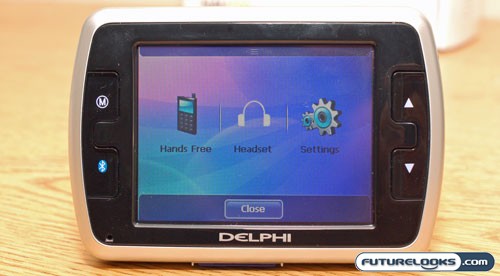Starting It Up

After powering it on from a cold start, the unit started up and acquired a signal in around 30 seconds under a clear sky. We did find that depending on how many buildings were nearby or how much cloud or smog cover there was, it could take up to a minute. Not bad. But before you can get underway, you need to agree to the huge disclaimer that you won’t do anything stupid like drive through a crosswalk when the GPS tells you to turn right or something. The best policy is don’t do anything that would get you on the evening news.
How It Keeps You From Getting Lost…
The best test for a GPS system, in my humble opinion, is to take it to a totally unfamilar city and try to get around with just the system. If you get lost a lot, you’ll know it’s….crap… Luckily, the NAV300 comes with some tricks up its sleeve that will keep you on the right road.

First off, the screen gives you plenty of data to get you on and off even the most confusing interstate. The left hand side provides data like which direction to turn or which way to get off on the interstate while a visual meter tells you just how quickly it’s coming up as well as distance. There is also a speed limit indicator so that you’ll know exactly how much over the speed limit you were when the fuzz pulls you over. You can also set audible alarms to warn you when you are X amount over the limit. This can be done indepently for urban areas and interstates or highways. I did notice that the speed indicator only seemed to work in the US, but not so much in Canada.
Also very useful for multi-lane interstates like the ones in Los Angeles was the lane indicator that told me which lanes to be in for my next turn off. I also found the estimated time of arrival to be a great way to plan for breaks or for dinner at the nearest ZAGAT Rated restaurant and the branded points of interest made it easy to see where the next Starbucks is.
Taking It On The Road
After spending a lot of time driving around totally unfamiliar places like Los Angeles and Seattle to my backyard of Vancouver, I’ve really gotten to know the NAV300. For starters, in Los Angeles, I found that being able to see which lane, which direction, and how quickly my exits were coming up were a total life saver. In a city where it seems that everyone drives slow in the left lane for no apparent reason (while talking on the phone, no headset), or sometimes the WRONG WAY on a one way street, it really allowed me to setup for my exits properly. I was also impressed with how quickly it rerouted me if I totally screwed up.
I found it similarly helpful in Seattle where I have no clue where I’m going. Armed with just addresses, I was able to navigate with the help of the NAV300 and found that it was accurate to within a 10 – 20 feet of the turns I needed to take. The visual indicators also provided good warning so I could plan ahead for getting into the proper lanes for the next turn. Because of the horrid traffic jams in both cities, I would have loved to have tried out the Real-Time Traffic Data add on to see how well it dealt with routing me around traffic.
In the more familiar surroundings of Vancouver, the NAV300 took me on routes that did the trick, but seemed to pick ones that took me straight through the city which is often plagued with mini traffic jams. However, with the way that Vancouver is laid out, the routes weren’t horrible by any means, but seemed more appropriate for non-peak hours. Just for fun, I did take a lot of wrong turns but it seemed to re-route quickly and send me on my way. Some earlier reviews seemed to have problem with the re-routing, but it looks to be fixed in the latest software.
I did notice however that in all three cities, there were instances where the turns were labelled or spoken, they didn’t match what was on the signs on the road. I found this more of an annoyance. However, I ended up just paying more attention to the great visual indicators when something didn’t seem to make sense. When driving at night, the display colours can be inverted, making it easier to look at in the dark.
Bluetooth Hands Free Action
One of the features that I tended to use a lot was the hands-free Bluetooth system built into the NAV300. I loved how I didn’t have to wear a dorky headset to be able use my phone in the car. Once my handset (a Dopod C500) was paired with the NAV300, it would automatically connect everytime I got in and out of the car. Even the call display worked, allowing me to answer or reject the call with just a tap of the screen. You can also program frequently used numbers into the NAV300 labelled with a voice command. Speaking of voice commands, you can also program locations with voice commands and call them up from the main navigation screen by hitting options then voice command.

The only thing that was a little tedious was the placement of the microphone. I thought I could put it anywhere, but this was not so. After fiddling around, I found that the best spot for the mic was clipped to your sun visor with the mic pointed right at your mouth. One tweak that I did find that provided better voice quality for the people I was talking to was to flip the visor down, slightly, getting the mic even closer to my face.
Real-Time Price and Stock Check – Shop Like a PRO!
